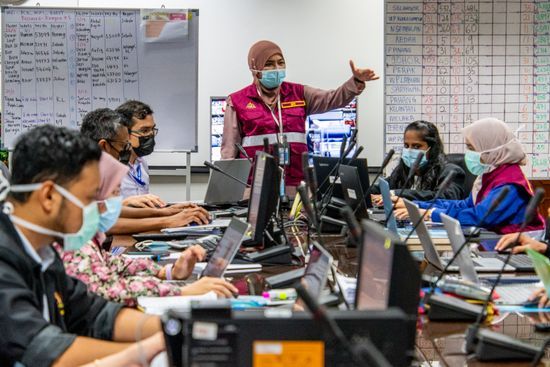
A Public Health Emergency Operations Centre (PHEOC) is a physical location for the coordination of information and resources to support incident management activities. PHEOCs are also referred to as “operations centres”, “situation rooms” and “command centres”. Experience has shown that timely implementation of a PHEOC provides an essential platform for the management of public health emergencies and can help avoid common failings such as lack of clear leadership leading to delayed decision making, mismanagement of resources and poor coordination.
This online course is designed as a companion to WHO’s Framework for a Public Health Emergency Operations Centre and is aimed at health emergency preparedness and response professionals, policy makers and partners seeking to implement and sustain Public Health Emergency Operations Centres.
Please note: These materials were launched on 16/12/2020. We kindly invite you to follow https://www.who.int/ for further information on PHEOC.
Photo credit: MYS/CPRC
Язык: English
English
COVID-19
Информация о курсе
Please note this course is in the process of being translated into all UN languages as well as select national languages. Translated versions are currently available in the following language(s):
македонски - Français - Русский - 中文 - Português - Español -ພາສາລາວ - Українська
Overview: In 2012, WHO established the Public Health Emergency Operations Centre Network (EOC-NET). WHO developed the Framework for a Public Health Emergency Operations Centre (PHEOC), in collaboration with EOC-NET partners. The Framework provides high-level methodical guidance for designing, developing and strengthening of PHEOCs. This online course provides an outline of the PHEOC Framework and relevant references.
Learning objectives: By the end of this course, you should be able to:
- describe the content of the PHEOC Framework;
- explain the key concepts of PHEOCs and emergency management;
- define the objectives and function of PHEOCs;
- describe major planning and implementation considerations, the core components and essential requirements of a PHEOC; and
- apply the PHEOC Framework and relevant tools for designing, developing and strengthening PHEOCs.
Course duration: Approximately 5 hours.
Certificate: A Record of Achievement certificate will be available to participants who score at least 80% of the total points available across both of the learning check quizzes and complete the activities section. Participants who receive a Record of Achievement can also download an Open Badge for this course. Click here to learn how.

Disclaimer: This course includes photographic depiction of Public Health Emergency Operation Centre (PHEOC) scenarios prior to the outbreak of COVID-19. Organizing a PHEOC facility during the current pandemic context will require additional occupational health precautions not discussed in this course. Please adhere to your local national guidelines on COVID-19 precautions, including physical distancing of at least 1 metre as well as appropriate usage of masks when indicated. More information on these and other relevant workplace precautions can be found in the OpenWHO course: COVID-19 and work: Staying healthy and safe at work during the COVID-19 pandemic
Содержимое курса
Introduction: Overview of the course and the PHEOC Framework:
This introductory module lists the course objectives; describes the course contents; and describes the PHEOC Framework, as well as other key documents.Module 1: Key concepts and principles:
Module 1 consists of three units: The PHEOC; Principles of emergency management; and The Incident Management System (IMS).Module 2: Implementing the PHEOC:
Module 2 consists of seven units: Planning guidance; Physical structure and Information and Communication Technology (ICT); PHEOC plans and procedures; Information systems; Human resources and trainings; Exercises; and Monitoring, evaluation and financing.Activities: Learning check tasks:
This final module offers three activities that will help you practice applying the information from the Framework and using the Annexes.
Записаться на этот курс
Требования для получения сертификата
- Чтобы получить сертификат об окончании курса, участникам необходимо набрать не менее 80% от максимального количества баллов за все задания на оценку.
- Gain an Open Badge by completing the course.